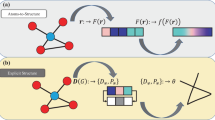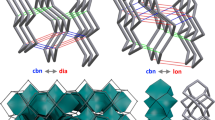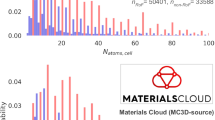Abstract
The systematic enumeration of all possible networks of atoms ininorganic structures is of considerable interest. Of particular importance are the 4-connected networks (those in which each atom is connected to exactly four neighbours), which are relevant to a wide range of systems — crystalline elements, hydrates, covalently bonded crystals, silicates and many synthetic compounds. Systematic enumeration is especially desirable in the study of zeolites and related materials, of which there are now 121 recognized structural types1, with several new types being identified every year. But as the number of possible 4-connected three-dimensional networks is infinite, and as there exists no systematic procedure for their derivation, the prediction of new structural types has hitherto relied on empirical methods (see, for example, 2–4). Here we report a partial solution to this problem, basedon recent advances in mathematical tiling theory5,6,7,8. We establish that there are exactly 9, 117 and 926 topological types of, respectively, 4-connected uninodal, binodal and trinodal networks, derived from simple tilings based on tetrahedra. (Here nodality refers to the number of topologically distinct vertices from which the network is composed.) We also show that there are at least 145 more distinct uninodal networks based on a more complex tiling unit. Of the total number of networks that we have derived, only two contain neither three- nor four-membered rings, and most of the binodal and trinodal networks are new.
This is a preview of subscription content, access via your institution
Access options
Subscribe to this journal
Receive 51 print issues and online access
$199.00 per year
only $3.90 per issue
Buy this article
- Purchase on Springer Link
- Instant access to full article PDF
Prices may be subject to local taxes which are calculated during checkout



Similar content being viewed by others
References
Meier, W. M., Olson, D. H. & Baerlocher, C. Atlas of Zeolite Structure Types (Elsevier, London, 1996); updates available at 〈http://www.iza-sc.ethz.ch/IZA-SC/Atlas/AtlasHome.html〉.
Smith, J. V. Topochemistry of zeolites and related materials. 1. Topology and geometry. Chem. Rev. 88, 149–182 (1988).
O'Keeffe, M. & Hyde, B. G. Crystal Structures I: Patterns and Symmetry (Monograph, Mineralogical Assoc. of America, Washington DC, 1996).
Treacy, M. M. J., Randall, K. H., Rao, S., Perry, J. A. & Chadi, D. J. Enumeration of periodic tetrahedral frameworks. Z. Kristallogr. 212, 768–791 (1997).
Dress, A. W. M., Huson, D. H. & Molnár, E. The classification of face-transitive periodic 3-dimensional tilings. Acta Crystallogr. A 49, 806–817 (1993).
Dress, A. W. M. in Springer Lecture Notes In Mathematics Vol. 1172, 56–72 (Springer, Göttingen, 1985).
Dress, A. W. M. Presentations of discrete groups, acting on simply connected manifolds, in terms of parametrized systems of Coxeter matrices: a systematic approach. Adv. Math. 63, 196–212 (1987).
Huson, D. H. Combinatorial tiling theory: theorems-algorithms-visualization.At 〈http://www.mathematik.uni-bielefeld.de/∼delgado/Tiling-Theory〉.
O'Keeffe, M. & Brese, N. E. Uninodal 4-connected 3D nets. I. Nets without 3-rings or 4-rings. Acta Crystallogr. A 48, 663–669 (1992).
Huson, D. H. The generation and classification of tile-k -transitive tilings of the Euclidean plane, the sphere and the hyperbolic plane. Geometriae Dedicata 47, 269–296 (1993).
Delgado Friedrichs, O., Dress, A. W. M., Müller, A. & Pope, M. T. Polyoxometalates: a class of compounds with remarkable topology. Mol. Eng. 3, 9–28 (1993).
Kepler, J. Harmonices Mundi Libri V Book II, Sections 18–20, pp 51–56 (Linz, 1619).
Heesch, H. Über Raumteilungen. Nachr. Gesellschaft Wiss. Göttingen 1, 35–42 (1934).
Delgado Friedrichs, O. Euclidicity criteria for three-dimensional branched triangulations.Thesis, Univ. Bielefeld(1994).
Brunner, G. O. & Laves, F. Zum Problem der Koordinazionszahl. Wiss. Z. Tech. Univ. Dresden 20, 387–390 (1971).
Meier, W. M. & Moeck, H. J. The topology of three-dimensional 4-connected nets: classification of zeolite framework types using coordination sequences. J. Solid State Chem. 27, 349–355 (1979).
Wells, A. F. Three-Dimensional Nets and Polyhedra (Wiley, New York, 1977).
Wells, A. F. Further Studies of Three-Dimensional Nets (Am. Crystallographic Assoc. Monogr. No. 8, Polycrystal Book Service, Pittsburgh, 1979).
Grünbaum, B. Uniform tilings of 3-space. Geombinatorics 4, 49–56 (1994).
Gramlich-Meier, R. & Meier, W. M. Constituent units and framework conformations in zeolite networks. J. Solid State Chem. 44, 41–49 (1982).
Acknowledgements
We thank M. O'Keeffe for discussions.
Author information
Authors and Affiliations
Corresponding author
Supplementary information
Rights and permissions
About this article
Cite this article
Friedrichs, O., Dress, A., Huson, D. et al. Systematic enumeration of crystalline networks. Nature 400, 644–647 (1999). https://doi.org/10.1038/23210
Received:
Accepted:
Issue Date:
DOI: https://doi.org/10.1038/23210
This article is cited by
-
Open-channel metal particle superlattices
Nature (2022)
-
My friend Alan Mackay
Structural Chemistry (2017)
-
Crystal structures as periodic graphs: the topological genome and graph databases
Structural Chemistry (2017)
-
How to describe disordered structures
Scientific Reports (2016)
-
In silico prediction and screening of modular crystal structures via a high-throughput genomic approach
Nature Communications (2015)
Comments
By submitting a comment you agree to abide by our Terms and Community Guidelines. If you find something abusive or that does not comply with our terms or guidelines please flag it as inappropriate.



